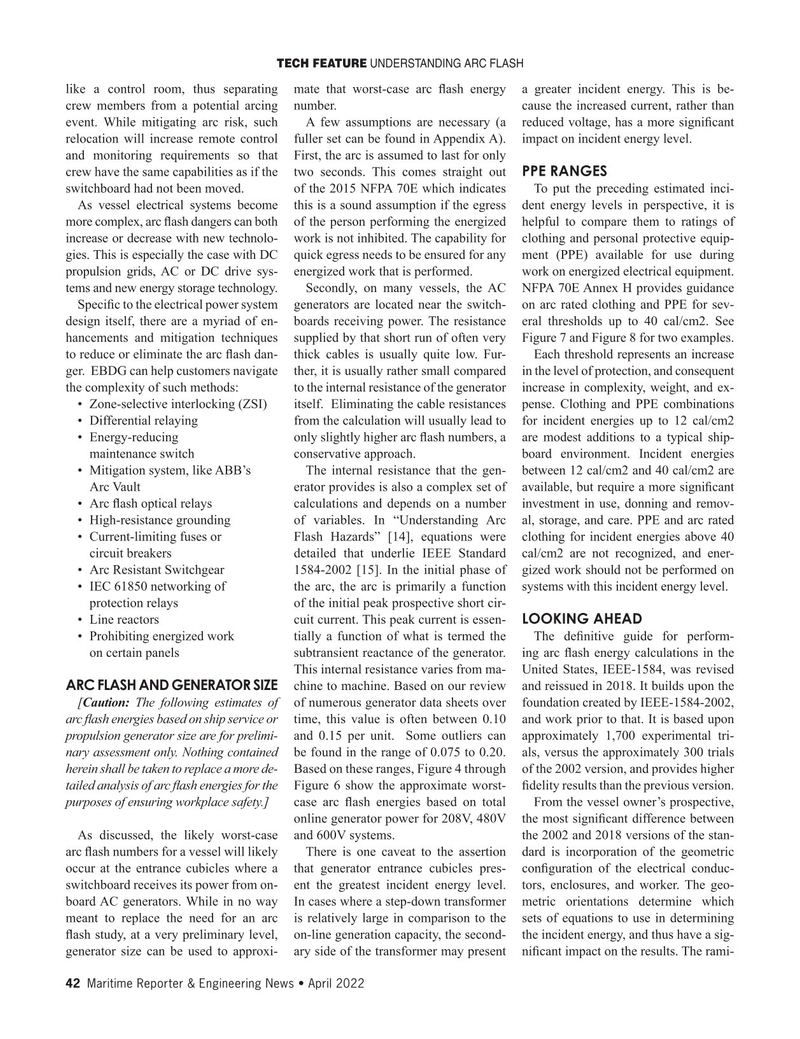
Page 42: of Maritime Reporter Magazine (April 2022)
Offshore Energy
Read this page in Pdf, Flash or Html5 edition of April 2022 Maritime Reporter Magazine
TECH FEATURE UNDERSTANDING ARC FLASH like a control room, thus separating mate that worst-case arc ? ash energy a greater incident energy. This is be- crew members from a potential arcing number. cause the increased current, rather than event. While mitigating arc risk, such A few assumptions are necessary (a reduced voltage, has a more signi? cant relocation will increase remote control fuller set can be found in Appendix A). impact on incident energy level.
and monitoring requirements so that First, the arc is assumed to last for only crew have the same capabilities as if the two seconds. This comes straight out PPE RANGES switchboard had not been moved. of the 2015 NFPA 70E which indicates To put the preceding estimated inci-
As vessel electrical systems become this is a sound assumption if the egress dent energy levels in perspective, it is more complex, arc ? ash dangers can both of the person performing the energized helpful to compare them to ratings of increase or decrease with new technolo- work is not inhibited. The capability for clothing and personal protective equip- gies. This is especially the case with DC quick egress needs to be ensured for any ment (PPE) available for use during propulsion grids, AC or DC drive sys- energized work that is performed. work on energized electrical equipment. tems and new energy storage technology. Secondly, on many vessels, the AC NFPA 70E Annex H provides guidance
Speci? c to the electrical power system generators are located near the switch- on arc rated clothing and PPE for sev- design itself, there are a myriad of en- boards receiving power. The resistance eral thresholds up to 40 cal/cm2. See hancements and mitigation techniques supplied by that short run of often very Figure 7 and Figure 8 for two examples.
to reduce or eliminate the arc ? ash dan- thick cables is usually quite low. Fur- Each threshold represents an increase ger. EBDG can help customers navigate ther, it is usually rather small compared in the level of protection, and consequent the complexity of such methods: to the internal resistance of the generator increase in complexity, weight, and ex- • Zone-selective interlocking (ZSI) itself. Eliminating the cable resistances pense. Clothing and PPE combinations • Differential relaying from the calculation will usually lead to for incident energies up to 12 cal/cm2 • Energy-reducing only slightly higher arc ? ash numbers, a are modest additions to a typical ship- maintenance switch conservative approach. board environment. Incident energies • Mitigation system, like ABB’s The internal resistance that the gen- between 12 cal/cm2 and 40 cal/cm2 are Arc Vault erator provides is also a complex set of available, but require a more signi? cant • Arc ? ash optical relays calculations and depends on a number investment in use, donning and remov- • High-resistance grounding of variables. In “Understanding Arc al, storage, and care. PPE and arc rated • Current-limiting fuses or Flash Hazards” [14], equations were clothing for incident energies above 40 circuit breakers detailed that underlie IEEE Standard cal/cm2 are not recognized, and ener- • Arc Resistant Switchgear 1584-2002 [15]. In the initial phase of gized work should not be performed on • IEC 61850 networking of the arc, the arc is primarily a function systems with this incident energy level.
protection relays of the initial peak prospective short cir- • Line reactors cuit current. This peak current is essen- LOOKING AHEAD • Prohibiting energized work tially a function of what is termed the The de? nitive guide for perform- on certain panels subtransient reactance of the generator. ing arc ? ash energy calculations in the
This internal resistance varies from ma- United States, IEEE-1584, was revised
ARC FLASH AND GENERATOR SIZE chine to machine. Based on our review and reissued in 2018. It builds upon the [Caution: The following estimates of of numerous generator data sheets over foundation created by IEEE-1584-2002, arc ? ash energies based on ship service or time, this value is often between 0.10 and work prior to that. It is based upon propulsion generator size are for prelimi- and 0.15 per unit. Some outliers can approximately 1,700 experimental tri- nary assessment only. Nothing contained be found in the range of 0.075 to 0.20. als, versus the approximately 300 trials herein shall be taken to replace a more de- Based on these ranges, Figure 4 through of the 2002 version, and provides higher tailed analysis of arc ? ash energies for the Figure 6 show the approximate worst- ? delity results than the previous version.
purposes of ensuring workplace safety.] case arc ? ash energies based on total From the vessel owner’s prospective, online generator power for 208V, 480V the most signi? cant difference between
As discussed, the likely worst-case and 600V systems. the 2002 and 2018 versions of the stan- arc ? ash numbers for a vessel will likely There is one caveat to the assertion dard is incorporation of the geometric occur at the entrance cubicles where a that generator entrance cubicles pres- con? guration of the electrical conduc- switchboard receives its power from on- ent the greatest incident energy level. tors, enclosures, and worker. The geo- board AC generators. While in no way In cases where a step-down transformer metric orientations determine which meant to replace the need for an arc is relatively large in comparison to the sets of equations to use in determining ? ash study, at a very preliminary level, on-line generation capacity, the second- the incident energy, and thus have a sig- generator size can be used to approxi- ary side of the transformer may present ni? cant impact on the results. The rami- 42 Maritime Reporter & Engineering News • April 2022
MR #4 (34-49).indd 42 MR #4 (34-49).indd 42 4/5/2022 11:06:15 AM4/5/2022 11:06:15 AM

 41
41

 43
43
